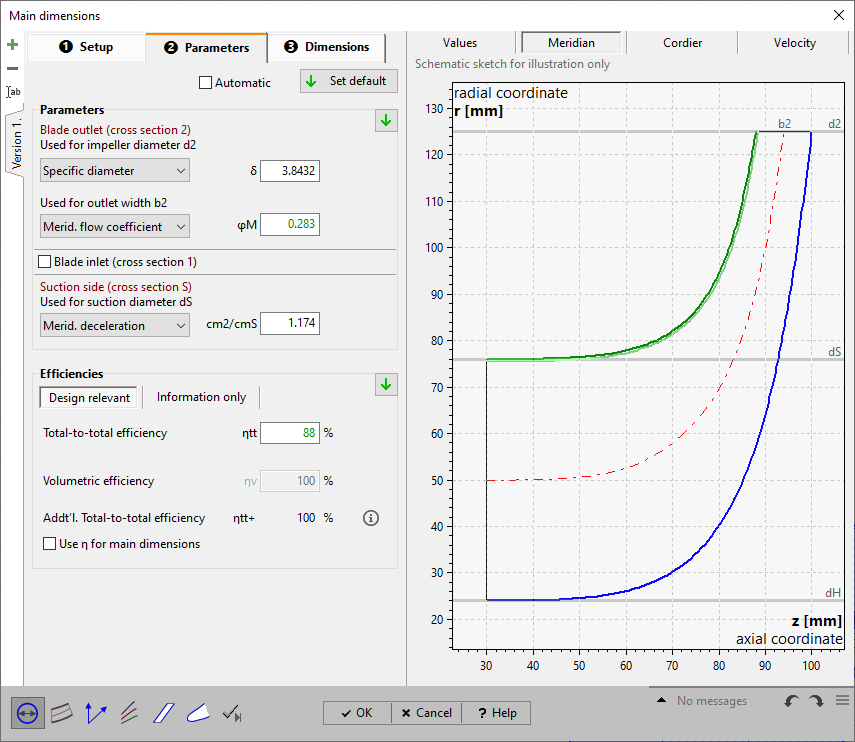|
<< Click to Display Table of Contents >> Parameters |
  
|
|
<< Click to Display Table of Contents >> Parameters |
  
|

On page Parameters you have to put in or to modify parameters resulting from approximation functions in dependence on specific speed nq or flow rate Q.
See Approximation functions.
For details of how to handle the parameter edit fields please see Edit fields with empirical functions.
|
Parameter and efficiency values can be handled manually or can be switched to automatic update by the checkbox on top of the page. Then the default values are used always, even after design point modifications (see Global setup). |
If the automatic mode is not selected the current default values can be specified by one of the following options:
|
globally by the button on top of the page |
|
regionally by the default button within the Parameters or Efficiency region |
|
individually by the default button within the input field when selected |
The panel Parameters allows defining alternative values in each case for the calculation of the following impeller main dimensions: •suction diameter dS •impeller diameter d2 •impeller width b2 |
|
For d2-calculation
Work coefficient Ψ (= pressure and head coefficient) |
▪dimensionless expression for the specific enthalpy Δhis=Y and Δh=Yeff resp.
▪high → small d2, flat characteristic curve |
Flow coefficient φ |
▪dimensionless flow rate 0.01 narrow centrifugal impeller, untwisted blades 0.15 mixed-flow impeller, twisted blades |
Specific diameter δ |
▪according to Cordier diagram (see Dimensions) |
Machine Mach number Mau |
▪dimensionless peripheral speed of impeller related to total inlet speed of sound |
Peripheral speed u2 |
▪Limiting values due to strength as a function of the material |
For b2-calculation
Outlet width ratio b2/d2 |
▪0.01...0.15 (with nq rising) |
Meridional flow coefficient φm |
▪dimensionless flow rate 0.10...0.50 (with nq rising) |
Abs. outlet flow angle α2 |
▪16°...30° |
For dLE-calculation (optional)
Diameter ratio dLE/d2 |
dLE/d2=0.3...0.8 |
Relative deceleration w2/wLE |
w2/wLE>0.7 or f(b2/d2) |
For bLE-calculation (optional)
Meridional deceleration cm2/cmLE |
cm2/cmLE = 0.8...1.25 |
for dS-calculation
Meridional deceleration cmLE/cm1 or cm2/cm1 |
cmLE/cm1 = 0.9...1.1 |
Relative inlet flow angle β1 |
|
Relative inlet Mach number MwS |
|
Diameter ratio dS/d2 |
dS/d2 = 0.65...0.8 |
In panel Efficiency you have to specify several efficiencies. You have to distinguish between design relevant efficiencies and efficiencies used for information only:
Design relevant
•total-total efficiency ηtt
•volumetric efficiency ηv
•additional total-total efficiency ηtt+ (displayed for information only, see Global setup)
Information only
•mechanical efficiency ηm
•motor efficiency ηmot
The additional total-total efficiency ηtt+ is used for impeller dimensioning in order to compensate additional flow losses.
The losses resulting in energy dissipation from the fluid form the internal efficiency.
![]()
Impeller and mechanical efficiency form the overall efficiency (coupling efficiency) of the stage ηSt.
When considering motor losses additionally the overall efficiency of the stage incl. motor ηSt* is defined.
|
PQ: output power, see above PD: mechanical power demand (coupling/ driving power) |
|
Pel: electrical power demand of motor |
The following summary illustrates the single efficiencies and their classification:
classification |
efficiencies |
Relevant for impeller design |
||
stage |
|
ηC |
additional casing |
yes: for energy transmission |
ηtt |
total-total |
|||
impeller |
ηV |
volumetric |
yes: for flow rate |
|
|
ηm |
mechanical |
no: for overall information only |
|
stage incl. motor |
electrical |
ηmot |
motor |
The obtainable overall efficiency correlates to specific speed and to the size and the type of the impeller as well as to special design features like bypass installations and auxiliary aggregates. Efficiencies calculated by approximation functions are representing the theoretical reachable values and they should be corrected by the user if more information about the impeller or the whole machine are available.
The impeller efficiency ηtt describes the energy losses caused by friction and vorticity. Friction losses mainly originate from shear stresses in boundary layers. Vorticity losses are caused by turbulence and on the other hand by changes of flow cross section and flow direction which may lead to secondary flow, flow separation, wake behind blades etc.. The impeller efficiency is the ratio between the actual specific energy Y and the energy transmitted by the impeller blades without any losses:
![]()
The volumetric efficiency is a quantity for the deviation of effective flow rate Q from total flow rate inside the impeller ![]() which also includes the circulating flow within the casing:
which also includes the circulating flow within the casing:
![]() (rising with impeller size)
(rising with impeller size)
The mechanical efficiency mainly includes the friction losses in bearings and seals:
![]() (rising with impeller size)
(rising with impeller size)
Impeller efficiency and volumetric efficiency are most important for the impeller dimensioning because of their influence to ![]() and/or
and/or ![]() . The mechanical efficiency is affecting only the required driving power of the machine.
. The mechanical efficiency is affecting only the required driving power of the machine.
If the check box "Use η for main dimensions" is set, then main dimension calculation is done on the basis of Δh= 0.5(Δhis/η+Δhis). Otherwise Δhis - the isentropic specific enthalpy - is used.
In the right panel of the tab sheet Parameter you can find again some calculated values for information:
Required driving power |
|
Power loss |
|
Internal efficiency |
|
Stage efficiency |
|
Stage efficiency incl. motor |
|
Total-to-static efficiency |
(perfect gas model) |
Polytropic efficiency |
(n .. polytropic exponent κ .. isentropic exponent) |